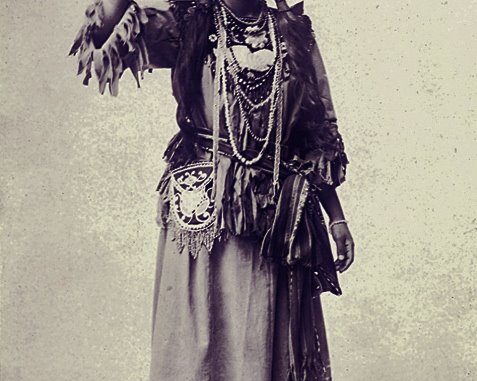
Where did the early women suffragists get their radical ideas about equality for women?
One source of inspiration, documented by feminist scholar Sally Roesch Wagner, was the Confederacy of the Six Nations of the Haudenosaunee (Iroquois). In these tribes, women had an equal voice in tribal government. They also enjoyed respect and authority in their families that their white sisters could only dream of.
Many of the early feminists lived next to the Haudenosaunee tribes in upstate New York. Their local newspapers carried articles about such things as council meetings and spiritual ceremonies.
Early suffragists including Matilda Joslyn Gage, Elizabeth Cady Stanton and Lucretia Mott had direct dealings with the tribes. Gage was especially prolific in writing about the Haudenosaunee and the position of their women.
While president of the National Woman Suffrage Association, Gage wrote a series of articles on the Iroquois that were featured in the New York Evening Post and reprinted in several other papers in New York. She was honored by being adopted into the Wolf Clan of the Mohawk Nation.
As a result of this widespread exposure, the average reader in upstate New York would have been quite familiar with the Iroquois culture and customs. Wagner noted in her book, Sisters in Spirit, that the suffragists “believed women’s liberation was possible because they knew liberated women, women who possessed rights beyond their wildest imagination: Haudenosaunee women.”
The confederacy included six nations: the Mohawk, Oneida, Onandaga, Cayuga, Seneca and Tuscarora. It was women’s responsibility (especially the clan mother) to choose the sachem (chief) of each clan, who would then represent the people in the Grand Council of the confederacy. If the sachem failed to represent the needs of the people, the women could depose him and choose another. In matters of war and peace, women and men had an equal voice. Women also had control over the clan’s land, because they cultivated it.
It was not only political rights that were enjoyed by the Haudenosaunee women. In stark contrast to white women of the 19th century, these Native women were also powerful in their families. Here are some examples:
Divorce: With the Natives, a misbehaving husband could be told at any time to “pick up his blanket and budge.” Until some laws were changed in the second half of the 19th century, Euro-American women were unable to leave a loveless or violent marriage. If they fled, they could be returned to their husbands by the police, just as runaway slaves could be returned to their masters.
Property and children: Among the Haudenosaunee, each member of the family — even the children — had control over his or her property. And, in case of divorce, the women kept her own property and her children. With the Euro-Americans, a married woman had to turn over her property, inheritance and earnings to her husband until the middle of the 19th century when some property laws were changed. Fathers always had custody of the children. A dying man with a pregnant wife could even “will away” custody of the unborn child to someone other than the mother.
Individual property rights were also recognized by other Native Americans. Emma Borglum spent time with the Dakota tribes and noticed a young Native woman giving two horses to a friend. Somewhat astonished, she explained to the woman that a white woman would consult her husband before giving such valuable presents. The Dakota woman answered proudly, “I would not be a white woman!”
Violence in the family: Wife battering was not tolerated by the Haudenosaunee, and rape was unheard of before the white man arrived on the continent. Among the clans, a family member could avenge a woman who was beaten by her husband, and it was believed that such a husband awaited eternal punishment in the afterlife. By contrast, American laws allowed a husband to physically punish both his wife and children as long as no lasting damage was done.
Spiritual practices: While the Christian religion had no female in the godhead, an important spiritual being for the Iroquois was Sky Woman. Christian women of the time were not allowed to preach, but Iroquois women had equal responsibilities in spiritual ceremonies.
According to Wagner, clan mothers in the six Haudenosaunee nations continue today to exercise the same political power they have enjoyed since the founding of the Confederacy in 909.
Source: Sisters in Spirit by Sally Roesch Wagner, 2001
February suffrage events: Loveland Museum, 503 N. Lincoln Ave.: Feb. 8, 11 a.m.–2 p.m., opening reception for special art exhibit, “Vote: A Centennial Celebration.” Feb. 20, 6-7 p.m., “The Passage of the 19th Amendment.” Both events are free, but registration is necessary.
Support Northern Colorado Journalism
Show your support for North Forty News by helping us produce more content. It's a kind and simple gesture that will help us continue to bring more content to you.
BONUS - Donors get a link in their receipt to sign up for our once-per-week instant text messaging alert. Get your e-copy of North Forty News the moment it is released!
Click to Donate
